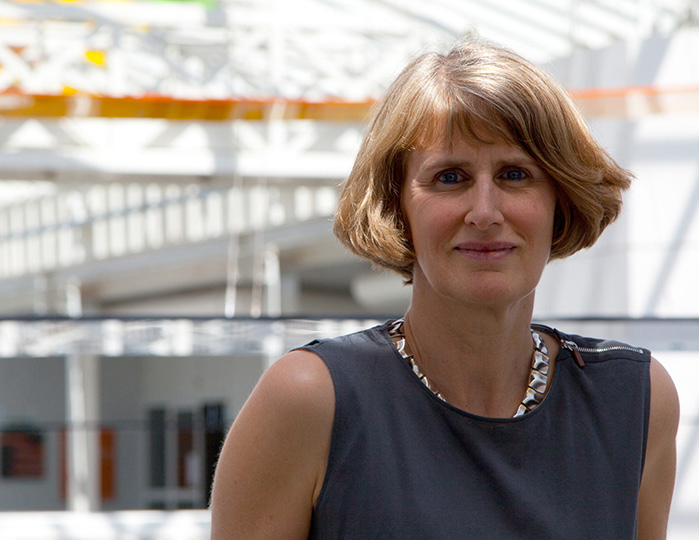Avril 2019
Entretien
Spotlight on... Pierrette Bouillon

See the original interview in French
In order to illustrate the topic of this interview, this article has been translated from French into English using the machine translation service DeepL. The translation was then post-edited using two different approaches: light post-editing and full post-editing. In the light post-edited version, the translator only corrected errors that could affect the reader’s understanding of the text, while in the full post-edited version below, the translator made significant changes in order to obtain a quality similar to human translation. Note that the translator identified errors, not only in the machine translation, but also in the original French text, thereby proving once again that translators are as indispensable to machine translation as machines are to today’s translators.
Pierrette Bouillon is Dean of the Faculty of Translation and Interpreting (FTI). She has been a professor at the FTI since 2007 and is also head of the Department of Translation Technology. Pierrette is actively involved in a number of Swiss and European projects in the field of machine translation. She co-leads the BabelDr project in collaboration with the Geneva University Hospitals, and works with the Zurich University of Applied Sciences for the new Swiss Research Center for Barrier-free Communication, in addition to being a part of the new European Cooperation in Science & Technology Network, “EnetCollect – European Network for Combining Language Learning with Crowdsourcing Techniques”. She has published widely in the field of computer linguistics and language processing, in particular in lexical semantics, automatic speech translation in specific fields, and, more recently, in the area of pre- and post-editing, which is the subject of today’s interview.
1. Last summer, you were appointed Dean of the FTI. What are your priorities over the next four years?
We need to respond to changes in our professions and teaching methods. I would therefore like to strengthen the links between our three departments by better integrating technology into our training programmes. I also want to encourage transversal projects that exploit the skills of all our departments, in addition to continuing to develop technologically innovative projects in partnership with the city and various companies. As Dean, one of my main goals is to develop post-editing research and teaching.
2. Explain to us what post-editing is.
Machine translation has made significant progress over the past decade. It now holds an important place in the translation industry, alongside translation memories. After fifty years of research in the field, we’re finally at a stage where machine translation can actually be useful for translators. But even though we’ve made enormous progress, particularly with neural technology, the results are still far from perfect. That’s why we need post-editing. This is when professionally trained translators and linguists proofread and correct a text produced by machine translation.
3. What is the current role of post-editing in your Faculty?
We’ve been working on machine translation and post-editing for many years. We’re one of the first translation faculties to have offered training in these two areas. We also participated in Eurotra, one of the first machine translation research projects. Our new curriculum includes more technology courses for translators, as well as an MA in Multilingual Communication Technology, which trains translation technology specialists who have a strong background in languages.
In terms of post-editing, we launched a new continuing education module on the topic this year. The course attracted over 40 participants and was a great success. At the same time, we’re also working with several Swiss companies to help them train MT systems, correctly integrate post-editing into their language services, and train and monitor their translation teams. For example, we’re currently working with the Swiss Post’s language service to test the implementation of MT from German into French, Italian and English. The aim is to compare several MT systems and test different MT-integrated translation environments. As researchers, this is a valuable opportunity for us to work with company data and test our hypotheses with professional translators.
4. What results have you already gotten from this project with the Swiss Post?
We’ve learned that the integration of MT is effective when used by trained translators. It’s also important for the MT to be of good quality and have the capacity to improve over time, taking into account the translators’ corrections. We’ve ensured that the translators receive specific training before getting them to use and evaluate the system. It’s important for them to be actively involved so that they will be receptive to the new systems and can overcome any bias that could affect the outcome of their assessments. The first step is to provide them with good quality MT so that they aren’t spending all their time correcting machine errors. We then explain to them how it works. A good understanding of the tool allows translators to make optimal use of the MT.
5. What does the future hold?
The quality of MT has improved so much that it can finally be a real help to translators today. Nevertheless, a machine will never be able to produce a translation of the same quality as humans, which is why we will always need humans to validate machine translations. For now, the computer can only translate sentence by sentence, without taking into account the context or underlying meanings of the text. We also have to remember that the current machine translation systems are based on data that was translated by humans.
However, the translation profession is bound to change. Thierry Fontenelle sums it up well in the title of a presentation he gave as Head of the Translation Department at the Translation Centre for the Bodies of the European Union: the translator will not be replaced by technology, but by a translator who uses technology. Translating repetitive texts will become easier, which is a good thing! It means that translators will have the time to translate more content, providing us with access to texts that were not available before. In fact, only 1% of the content produced today is translated. Machines can therefore help promote texts written in languages other than English and foster an openness to other cultures. Soon, we’ll even be able to automatically translate pictograms, Braille and sign language into simple texts.
